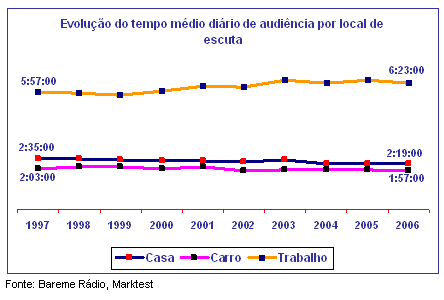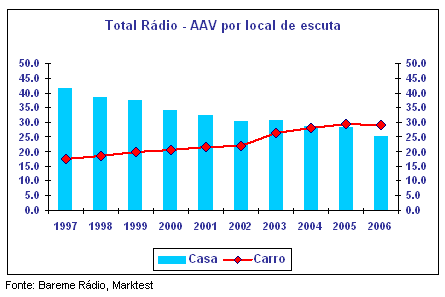Escuta de rádio nos EUA a cair; on line a subir; carro ameaçado
«U.S. radio’s ratings weakness continues, with fall numbers down 1.3%. Commenting recently on the latest Arbitron ratings, JP Morgan analysts John Blackledge and Aaron Chew noted that radio’s “average quarter hour persons 25–54” has dropped in 25 of the past 29 books and was up only once in six years. Reviewing fall numbers, they said in-car ratings in this demographic were flat; and with increasing use of mobile technologies and penetration of satellite radio and MP3 devices, “in-car ratings will face greater challenges going forward.”
In the Fall 2006 ratings book, AQH P25-54 ratings at home declined about 4%, while ratings at work were flat, the analysts said. Those ratings at home and at work have declined 2.8% and 2.6%, respectively, annually since 1998 “due to more media choices available for listeners at home and at work.” But Internet radio’s unique visitors are up about 22% year over year, and terrestrial radio operators represented about 37% of unique visitors among key Internet radio operators, up from a 26.3% share a year earlier. The analysts think terrestrial radio’s online investments are “starting to take hold” and said increases in unique visitors over the past year are well above the growth of non-broadcast Internet radio operators. “With the addition of rich content and Web streaming functionality to their Web sites, the operators are attracting more users, driving advertising revenue.” »
fonte: «Radio's Ratings Continue to Fall, While Online Visits Bubble, Radio World, 16/03/07
 Atendendo a que o carro é o local onde mais indivíduos ouvem rádio hoje em dia, é particularmente relevante que o tempo médio setenha mantido próximo das 2h diárias ao longo destes 10 anos abordados. Por outro lado, o local de trabalho apresenta uma tendência de subida, reforçando valores já elevados, enquanto que em casa a ligeira descida verificada é bem menos significativa do que outros aspectos, nomeadamente o peso deste local no total da escuta de rádio, já abordado no artigo anterior.»
Atendendo a que o carro é o local onde mais indivíduos ouvem rádio hoje em dia, é particularmente relevante que o tempo médio setenha mantido próximo das 2h diárias ao longo destes 10 anos abordados. Por outro lado, o local de trabalho apresenta uma tendência de subida, reforçando valores já elevados, enquanto que em casa a ligeira descida verificada é bem menos significativa do que outros aspectos, nomeadamente o peso deste local no total da escuta de rádio, já abordado no artigo anterior.»